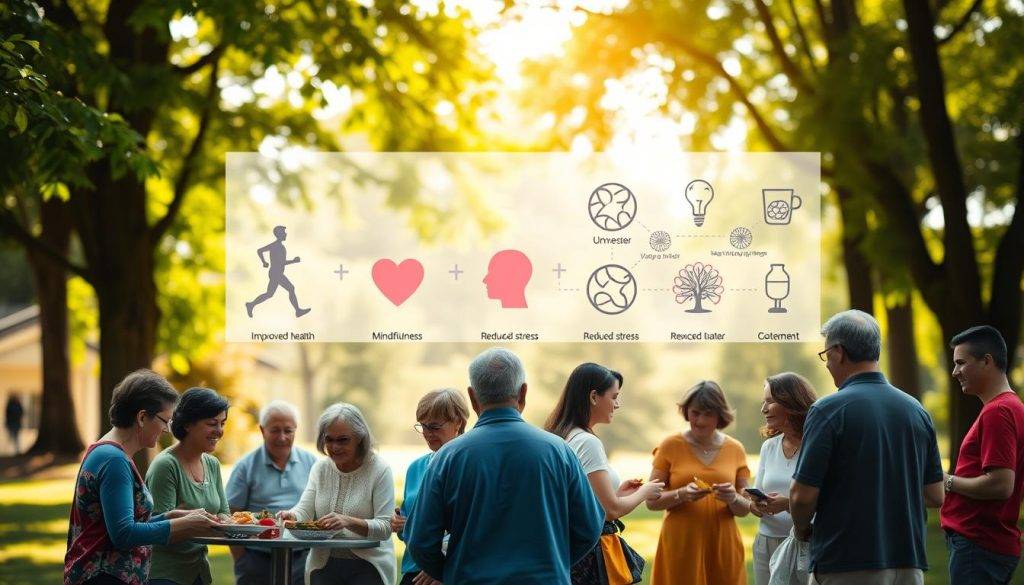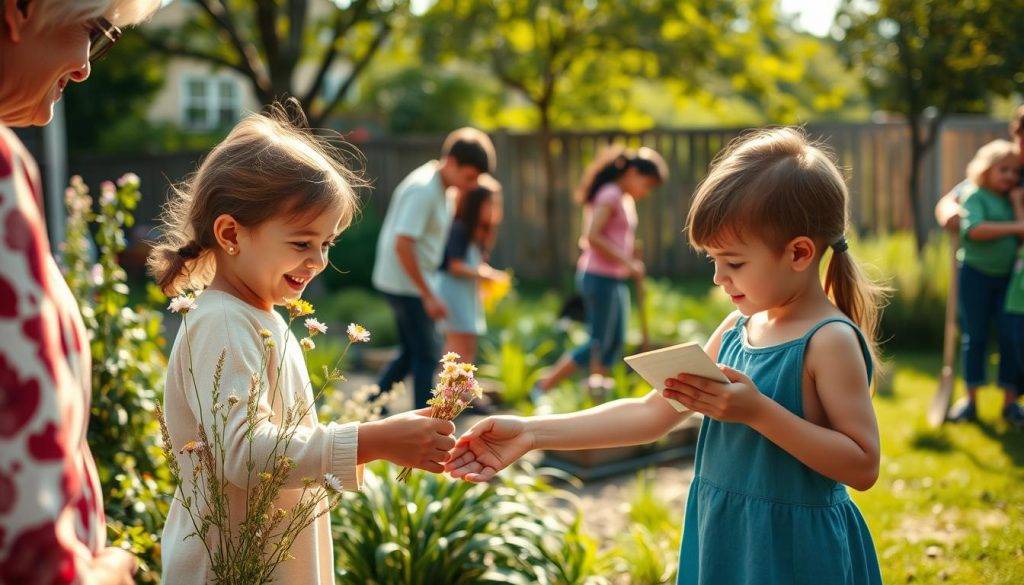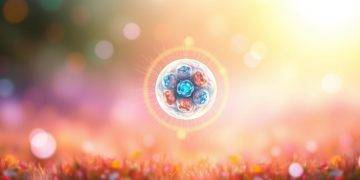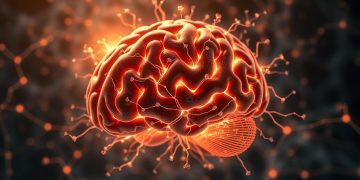Winston Churchill once observed: “We make a living by what we get, but we make a life by what we give.” This truth resonates through modern science as researchers uncover how generosity activates our biological reward systems. Studies from Harvard reveal that supporting others triggers measurable improvements in emotional well-being—effects that outlast temporary pleasures from personal indulgences.
When individuals engage in acts of kindness, their brains light up in regions linked to social bonding and trust. Neurochemicals like dopamine and oxytocin flood the system, creating what psychologists call the “helper’s high”. This biochemical cascade explains why sharing resources often feels more satisfying than acquiring them.
Evolutionary biology suggests this response developed to strengthen community survival. Today, this ancient wiring offers a practical blueprint for modern fulfillment. Through prosocial behavior—whether donating time or resources—people tap into a universal pathway to life satisfaction that transcends cultural and economic differences.
Key Takeaways
- Generosity activates brain regions tied to pleasure and social connection
- Neurochemical releases during giving create lasting emotional benefits
- Altruistic behavior shows measurable improvements in life satisfaction
- Prosocial actions strengthen both individual and community well-being
- Evolutionary biology explains humanity’s innate drive to help others
Understanding the Benefits of Giving
Modern science confirms what ancient wisdom suggests: sharing resources creates profound psychological rewards. Recent experiments reveal measurable patterns in how generosity shapes emotional states—patterns that defy common assumptions about self-interest.
Scientific Insights on Prosocial Spending
Harvard Business School analyzed 15 controlled trials involving money allocation. Participants who spent funds on others reported higher happiness levels than those prioritizing personal purchases. This effect appeared across cultures and income levels—even small gestures like buying coffee for strangers boosted mood.

Research Findings and the Warm Glow Effect
Brain scans from National Institutes of Health studies show why this happens. Acts of generosity activate the ventral striatum—a region processing rewards—and the septal area, which governs social bonding. “The warm glow isn’t poetic license,” explains neuroscientist Jorge Moll. “It’s literal neural activity linking altruism to primal pleasure systems.”
Surprisingly, people often misjudge these benefits. A 2008 study found participants underestimated the emotional impact of giving by 30-50%. This cognitive gap highlights why understanding research matters—it helps individuals make choices that align with proven paths to fulfillment.
How Generosity Boosts Physical and Mental Health
Scientific studies demonstrate a remarkable truth—caring for others directly strengthens your biological resilience. This connection between altruism and wellness shows up in cardiovascular data, brain imaging, and longevity statistics. Regular acts of generosity create measurable improvements that extend far beyond temporary mood lifts.

Reducing Stress and Enhancing Well-Being
Johns Hopkins University researchers found that people offering social support had lower blood pressure than those who didn’t. Brain scans reveal why: generous acts reduce activity in the amygdala—the fear center driving stress responses. This calming effect releases oxytocin and serotonin, chemicals that combat anxiety while promoting emotional stability.
A 15-year study of elderly volunteers showed striking results. Those who regularly helped others were 44% less likely to die within five years compared to non-volunteers—even when accounting for preexisting health conditions. The act of giving appears to buffer against stress-related illnesses like heart disease, offering protection mere medication can’t replicate.
Improving Longevity Through Altruism
University of Michigan research tracked couples who provided practical help to neighbors. These individuals experienced lower mortality rates than peers who received help but didn’t give. The pattern holds across age groups: teens volunteering weekly show stronger immune responses, while HIV patients practicing generosity report slower disease progression.
This isn’t just about feeling virtuous. Neurochemical changes during altruistic acts strengthen cellular repair mechanisms and reduce inflammation. As one researcher notes: “Helping others might be the most underrated health intervention available.” The data suggests that consistent generosity could add years to life—and life to years.
Cultivating a Giving Mindset for a Happier Life
Transforming generosity from occasional gestures into daily practice unlocks sustained emotional rewards. Research from UC Riverside reveals a clear pattern: participants who performed five intentional acts of kindness weekly saw measurable happiness increases within six weeks.

Embracing Daily Acts of Kindness
Active engagement proves critical. Holding doors open or offering genuine compliments creates stronger mood boosts than recalling past good deeds. This aligns with neurological studies showing real-time generosity triggers immediate dopamine release—a reward mechanism that fades when merely remembering kind acts.
Building a Habit of Generosity
Start small to avoid burnout. Researchers recommend beginning with two-minute actions like texting encouragement or donating spare change. These micro-acts create a positive cascade—each success fuels motivation for larger commitments.
Autonomy matters. Choosing causes that align with personal values amplifies emotional benefits by 37% compared to assigned tasks. This sense of control transforms obligation into joyful participation, making generosity sustainable.
Consistency beats grand gestures. Scheduling weekly “kindness windows” helps people feel connected without overwhelming schedules. Over time, these brief moments reshape neural pathways—turning compassion into instinct rather than effort.
Why Giving Makes You Feel Good: Psychological and Social Perspectives
Social networks act as amplifiers for generosity. Research by James Fowler and Nicholas Christakis reveals that kind acts create chain reactions—one person’s generosity can inspire positive behavior across three degrees of separation. This means helping a neighbor might ultimately uplift dozens through an invisible web of social connection.

The Role of Choice in Enhancing Happiness
Autonomy transforms obligation into joy. Studies show selecting how and where to contribute boosts the emotional impact by 37% compared to assigned tasks. When people direct their support—whether donating to animal shelters or mentoring students—brain scans reveal stronger oxytocin releases linked to lasting fulfillment.
Seeing the Impact: From Individual Acts to Community Benefits
Concrete results magnify the warm glow effect. Volunteers who witness their donations feeding families or building playgrounds experience doubled happiness spikes. As psychologist Paul Zak notes: “Seeing tangible outcomes activates neural pathways that abstract giving can’t match.”
This visibility strengthens community bonds. Neighborhoods with visible generosity projects show 22% higher cooperation rates in public initiatives. Each act becomes a catalyst—repairing parks inspires tree-planting drives, while food donations spark clothing collections. Through these ripples, individual choices collectively reshape social ecosystems.
Turning Research into Daily Generosity Practices
Translating scientific findings into sustainable generosity habits requires strategic design. Studies reveal that charitable giving delivers the greatest emotional rewards when paired with personal agency and visible community impact. This approach transforms abstract goodwill into measurable life improvements.

Practical Tips for Incorporating Giving into Your Routine
Start by aligning monetary spending with causes that mirror your values. Research suggests donating to local communities creates 23% stronger satisfaction than international efforts. For example, supporting a food bank lets you witness meals reaching neighbors—a tangible reinforcement of your contribution.
Combine financial support with hands-on involvement. One study found volunteers who also donate money report 40% higher well-being than those doing either alone. Try these research-backed methods:
- Schedule monthly “generosity hours” mixing donations with volunteer work
- Use employer matching programs to amplify your money contributions
- Practice expressing gratitude daily through notes or small favors
Workplace programs prove most effective when offering choice. Employees selecting where to direct spending report 31% higher engagement than those with mandated donations. This autonomy taps into the psychological benefits of purposeful act giving—proving even corporate initiatives can fuel personal fulfillment.
Remember: small, consistent actions outperform grand gestures. Helping someone else carry groceries or complimenting a colleague activates the same neural rewards as larger donations. As behavioral scientist Lara Aknin notes: “Daily micro-acts of generosity create compound interest for emotional well-being.”
Conclusion
Decades of interdisciplinary research confirm what social psychology now proves: prioritizing others creates measurable improvements in happiness and well-being. Studies across neuroscience, economics, and public health reveal consistent patterns—individuals who engage in charitable giving experience enhanced physical health, stronger social bonds, and lasting life satisfaction.
Gratitude emerges as a cornerstone of this effect. Researchers find that expressing appreciation activates neural pathways linked to social bonding and stress reduction. As one review notes: “The act of helping others provides unique psychological nourishment—a nutrient no self-focused behavior can replicate.”
Effective generosity combines personal choice with visible action. Research suggests selecting causes aligned with one’s values amplifies benefits by 37%. Simple practices—monthly donations with volunteer hours or mentoring colleagues—create compounding returns for both giver and receiver.
These findings empower individuals to approach generosity as intentional self-care. The data proves that supporting others strengthens immunity, extends lifespan, and builds community resilience. By embracing evidence-based giving strategies, people feel the profound rewards science continues to quantify—transforming everyday actions into catalysts for collective well-being.
FAQ
How does generosity improve physical health?
Studies link altruistic behavior to lower blood pressure and reduced stress hormones. Volunteering correlates with 23% lower mortality risk in adults over 55, suggesting generosity strengthens both community bonds and biological resilience.
What’s the “warm glow effect” in giving?
This psychological phenomenon describes the immediate happiness boost people experience when helping others. Neuroimaging research shows charitable acts activate the brain’s reward centers – the same regions stimulated by pleasurable activities like eating delicious food.
Can small daily acts of kindness make a difference?
Absolutely. A 2022 Nature Human Behaviour study found that performing micro-acts of generosity for seven days increased participants’ life satisfaction more than receiving gifts. Simple actions like holding doors or giving compliments create ripple effects in social networks.
How does choice influence the happiness gained from giving?
Research from the University of Zurich reveals that voluntary generosity triggers stronger neural reward signals than mandatory giving. This explains why personalized donations often feel more satisfying than automatic payroll deductions.
What’s the connection between gratitude and generosity?
Expressing gratitude activates brain pathways associated with social bonding, making people 20% more likely to pay kindness forward. This creates a positive feedback loop – generous acts inspire gratitude, which fuels further generosity.
How quickly can generosity practices reduce stress?
A UCLA study documented 28% lower cortisol levels in participants after just two weeks of daily prosocial behavior. Regular giving appears to buffer against stress by enhancing feelings of social connection and purpose.




























































